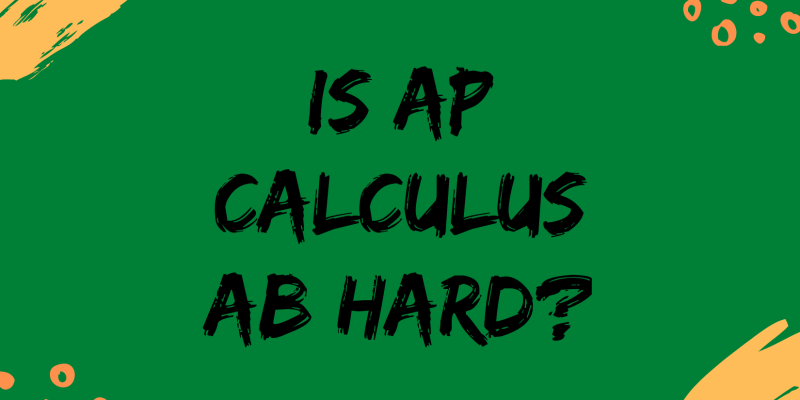
The AP Calculus AB exam is historically one of the hardest AP exams to pass. Its passing rate may look high at 58%, but that’s because it’s one of the less popular AP exams with a smaller self-selected group of students taking the exam.
It begs the question of whether or not it’s even worth taking AP Calc. At my high school, California High School in the Bay Area, there was only a small percentage of students who took the test, and Calculus was something that students dipped their toes in only at college. Before taking a test (and course) which will likely be one of the hardest you’ll take in high school, here are a few things that you should take into consideration.
| Scores in 2019 | 5 | 4 | 3 | 2 | 1 |
| AP® Calculus AB | 19.1% | 18.7% | 20.6% | 23.3% | 18.3% |
Most prestigious schools require or recommend high-school Calculus
The first is the fact that many of the STEM-related majors at prestigious universities require some level of Calculus knowledge as a condition for acceptance. Specific programs within University of Texas, Cornell University, and UVA top off this list.
The second is that even if these majors don’t require calculus as a condition for acceptance, many do begin using Calculus in the first year of coursework. Having a strong grasp of Calculus in high school will help you get a leg up in these challenging college classes. In addition, having the Calculus requirement knocked off will free your class schedule, because you’re not learning an admittedly difficult new skill while also acclimating to college and taking many of the “weed-out” classes for your major. Instead, you’re coming in with the knowledge and freeing yourself of a course resquirement.
That being said, if you’re going into a major which doesn’t have any kind of Calculus requirement, it’s probably unnecessary.
What is on the AP Calculus AB exam?
The content on the AP Course at a Glance splits the course material into 8 confusing different units. I think condensing them into 4 makes more sense for studying purposes.
The CollegeBoard Units:
- Limits and Continuity
- Differentiation: Definition and Basic Derivative Rules
- Differentiation: Composite, Implicit, and Inverse Functions.
- Contextual Applications of Differentiation
- Analytical Applications of Differentiation
- Integration and Accumulation of Change
- Differential Equations
- Applications of Integration
SoFlo’s Simpler 4 Units:
- Limits and Continuity
- Differentiation/Applications of Differentiation
- Implicit, Inverse, and Composite Functions
- Integration/Applications of Integration
Let’s go over these four major areas in a little more detail. As you’ll read, many of the CollegeBoard units can be grouped under one unifying concept. Also, many of the topics are interwoven into one another, such that knowing one skill can complement the other if used properly.
Limits and Continuity
This is a concept which was probably introduced to you in Precalculus, but having a strong grasp of limits is important to answer many of the questions on the AP exam. While there are usually only about 5-10 questions on limits which show up in the multiple choice, many of the concepts (Fundamental Theorem of Calculus, calculating local maxima and minima, etc..) are reliant on you being able to make good use of your knowledge on limits.
Differentiation/Applications of Differentiation
Differentiation, more colloquially referred to as taking the derivative, is almost always the first “real” Calculus concept you’ll ever learn. Differentiation, or finding the instantaneous slope of a curve (it’s really not as difficult as it sounds), is a skill which has far reaching applications in math and beyond. This, along with integration, makes up the “core” of what Calculus AB is really about. On the multiple-choice sections, you’ll get about 25-30 questions on differentiation, so it’s crucial you have a multifaceted understanding of what differentiation is. This includes being able to discern estimates of derivatives through a graph, differentiation of a straight equation, practical applications of derivatives, and understanding the relationship between differentiation and integration.
Implicit, Inverse, and Composite Functions
I decided to give these their own special group because although they are only a “type” of differentiation/integration, they are complex enough to classify as a whole other major area. Understanding how to implicitly differentiate (when the x’s and y’s are inseparable), how to differentiate or integrate inverse functions, and knowing how derivatives are affected by composite functions are all separate concepts which are important to keep in mind. Being able to identify these kinds of problems, and putting to use the more specialized tools in your toolkit to deal with them, is what will separate those who pass from those who don’t.
Integration/Applications of Integration
Integration is the second of the two major concepts in AP Calculus AB, and the skill which rounds out your fundamental understanding of Calculus. Essentially the skill of being able to find the area under a curve, integration is so heavily tied into differentiation that it is often called antidifferentiation. Integration has many practical benefits, and helps us gleam information from functions that we wouldn’t have had before. Dealing with integration along with its applications is something you need to become very familiar with to succeed on this test.
How is the AP Calculus Exam Structured
For information on the AP Calculus AB exam content, you can visit the CollegeBoard Course at a Glance, and for a description of the exam structure, you can visit the CollegeBoard AP Calculus AB course page. In brief, the structure has 2 components:
Section 1: Multiple Choice
Worth 50% of your score, this section is split into a calculator active and a non-calculator section. Many times on the calculator section, a knowledge of basic commands on a graphing calculator can help immensely, so make sure you a.) have a graphing calculator the day of the exam and b.) have a good grasp on Calculus-related graphing calculator commands.
Section 2: Free Response
Worth the remaining half of your score, this section is also split into two, but the way you tackle this section will be slightly different from the previous one. You need to be able to explain your thought process in a detailed manner, and knowing calculator commands is not enough to get through this section. This is again, an area where many students struggle, so it’s important to have a good understanding of Calculus to do well.
Calculus SAT Subject Test
SAT Subject tests are a good way to prove proficiency in Mathematics – after you’ve completed Calculus AB, you’ll be more than prepared to take this test on too. Many top-level universities look at your Subject Test scores as an affirmation of the grades you’ve gotten in these specific classes. And some even require a couple of Subject Tests for admission. SAT Math Level 2 is a good one to knock off, because it becomes almost easy after you’ve put yourself through AP Calculus AB.
Final Thoughts on the AP Calculus AB Exam
If you’re willing to put in the work to acquire a useful skill and knock off a college requirement simultaneously, AP Calculus AB is a good choice. From personal experience, it’s very satisfying to do well on the exam, considering it’s a completely new skill you’ve added to your arsenal. But if you don’t see this stuff aligning with your interests, there’s no reason to. And I’m begging you, please don’t take the AP Calculus AB exam just for the post-exam memes.
About the Author: Originally from the Bay Area, Pranav Anand studies Computer Science and Economics at the University of Pennsylvania. In his free time he likes to browse Twitter and debate Fortnite vs. Apex Legends.
Check out our new blog post: What to Bring to the SAT on Test Day 2021?










